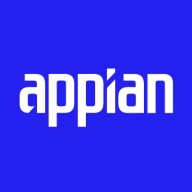

Both Appian and UiPath Process Mining are competitors in the area of business process management solutions. Appian has the upper hand in low-code application development, while UiPath excels in process mining and data visualization.
Features: Appian provides rapid low-code development, cohesive architecture, and seamless integration, making it intuitive for business users. Other valuable features include robust process design capabilities and a user-friendly interface. Meanwhile, UiPath Process Mining is distinguished by strong data visualization capabilities, the ability to pinpoint process inefficiencies, and integration with RPA bots, offering deep process insights and automation support.
Room for Improvement: Appian needs to improve UI customization, scalability, and enterprise integration flexibility. Users also face challenges with its mobility features. UiPath Process Mining could enhance pricing transparency, data integration, and user interface intuition, with difficulties in handling large datasets for real-time insights.
Ease of Deployment and Customer Service: Appian offers public, private, and hybrid cloud deployment options, and users often commend its technical support for being responsive, although there are remarks about improving response times. UiPath Process Mining also provides multiple deployment options, but struggles with complex on-premises integrations, and its customer support effectiveness varies.
Pricing and ROI: Appian is noted for flexible pricing and offers substantial ROI in digital transformation, despite some viewing initial costs as high. UiPath Process Mining is seen as costly with unclear licensing structures. UiPath offers competitive pricing relative to some competitors, yet pricing strategies need refinement for scalability and enterprise use.
Their customer service is responsive, and the team is very prompt for support.
Appian has a community where I can put my questions.
From a technical support standpoint, the SMEs are not confident enough in deciding what should be done.
UiPath provides exceptional customer service and support, primarily due to its active community forum, community.uipath.com, which offers 24/7 support from developers and community members.
They prioritize support based on the number of licenses purchased by an organization
Initially, without much coding, I can easily handle five thousand records.
There's significant room for enhancing process integration, data accuracy, and the general applicability of process mining.
UiPath as a whole is scalable and works well for large-scale organizations.
It depends on how it has been designed and how it has been configured.
We find UiPath Process Mining to be generally stable, particularly with the current build.
If there is a very complex process that includes a lot of data transitioning and memory-centric processes, it consumes a lot of memory.
UiPath Process Mining is associated with a high cost and a difficult learning curve for those unfamiliar with process mining tools.
It should focus on identifying opportunities for automation and resource allocation efficiently.
Maybe adding some competitor analysis would be beneficial, especially if I am using multiple tools.
On the pricier side, both Appian and Pega are enterprise-level solutions, placing them on the slightly higher side.
Compared to other solutions such as Power Automate, UiPath is significantly more expensive, with its pro plan starting at $420 per month.
It is a high price for a low rating.
I can create tables, perform database-related activities, and create multiple tables.
It is easy for me to define the process and create configurable workflows.
It provides root cause analysis, which identifies delays and deviations in processes, visualizes bottlenecks, and assesses their impact with insightful visualizations.
These elements allowed us to effectively understand and improve client interactions and manage complex data, especially in the context of banking operations.
The valuable features include analytics and dashboards.


Appian is a unified low-code platform and solution used by businesses to build enterprise applications and workflows. This product adapts to the needs of clients and the technologies they are already using to combine their data in a single workflow and maximize resources. The platform has four main components through which it transforms the work process for companies of various sizes. They are:
Appian is utilized across a diverse set of industries, including automotive and manufacturing, energy and utilities, education, financial services, telecom and media, transportation, retail, insurance, healthcare, and life sciences. The most frequent use cases of Appian are customer journey, governance, risk and compliance, operational efficiency, supply chain, distributed order management, and environmental, social, and governance (ESG) management.
Appian Features
Appian has various features that allow users to create solutions for their businesses. These features can be separated into a few groups according to function, including automation, low-code application development, and integrations and data. Some of the most frequently used features of Appian include:
Appian Benefits
The benefits of using Appian include:
Reviews from Real Users
A practice leader - digital process automation at a computer software company values Appian highly because the product is easy to develop, low-code, and has a good user interface.
Alan G., an advisory board member at Codecon VR, Appian offers a clear application life cycle, easy to learn documentation, and comes with a fundamentals course.
UiPath Process Mining is a process mining solution that provides businesses with a detailed understanding of their processes using the data from their organization applications (like CRM and ERP). In addition, UiPath Process Mining helps identify process pain points and bottlenecks and discover process improvement opportunities in order to increase efficiency, thereby reducing overall business costs.
UiPath Process Mining Features
UiPath Process Mining has many valuable key features. Some of the most useful ones include:
UiPath Process Mining Benefits
There are several benefits to implementing UiPath Process Mining. Some of the biggest advantages the solution offers include:
Reviews from Real Users
Below are some reviews and helpful feedback written by UiPath Process Mining users.
PeerSpot user Nilesh P., Associate Director - Cloud Architect at a computer software company, says, “It's easy to develop, maintain, and manage, and it helps in task mining and process mining.” He adds, "With UiPath in place, we are moving away from training people on the core applications, which are pretty complex. We've built a headless frontend, so it's really easy for anybody to join our company and be productive."
A Hyperautomation Architect at an insurance company mentions, “My shortlist of valuable features includes all the different types of analysis. For example, you can do a root cause analysis. In other words, if you have a process that has many different scenarios, you can identify where the problem is. You can also identify bottlenecks with root cause analysis. You do this by looking at the time that has been spent in specific stages or steps within the processes being performed. Another great feature is the ability to see processes at a higher level and take in the whole picture. If a process has too many variances — say there are 20 different ways of doing the task — you can identify which process is the one where that happens more often. This will prompt you to focus on that process for any possible ways to automate it and simplify the complexity.”
Karthikeyan M., Chief Sales & Marketing Officer - RPA evangelist at AQM Technologies, says, "For us, the most important feature of UiPath Process Mining is something called Document Understanding. We have found it to be extremely valuable, given that the current situation we have right now is that it's not just pure automation of manual and repetitive tasks. What we're doing is more along the lines of what you could call "intelligent" automation. Document Understanding plays a great role in this type of process automation because it helps us in automating the reading of documents better and, therefore, helps to automate intelligence for our customers."
We monitor all Process Mining reviews to prevent fraudulent reviews and keep review quality high. We do not post reviews by company employees or direct competitors. We validate each review for authenticity via cross-reference with LinkedIn, and personal follow-up with the reviewer when necessary.